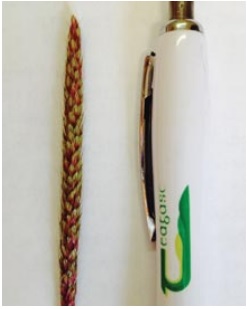Black grass was found in a number of crops through the country for the first time last year, according to Teagasc.
It says that this weed has been very problematic in the UK and is difficult (and expensive) to control due to herbicide resistance and every effort should be made to keep it from spreading on the farm.
And, this year Teagasc has, again, confirmed a few cases in parts of the country where it was never saw before.
Teagasc Tillage Specialist Tim O’Donovan told farmers at the recent corps and spraying event that it’s no harm for farmers to have a look around for it on their land.
Black grass is quite thin it’s got about a very distinctive 5mm diameter head on it.
O’Donovan said that, last year, Teagasc dealt with a few farms that had black grass and gave farmers programmes to deal with it.
“What worked very well was autumn cultivation then spray off with Roundup followed by spring barley.
“Using this approach we went from a stage were we had a population of black grass to none this year,” he said.
According to O’Donovan the trouble with black grass you’d like to see none of it rather than some of it.
He advised farmers to check around gaps where trailers are coming into fields.
“That’s where it starts to spread if its anywhere. The places where we have seen it is always coming out the gate and heading up along the yellow line on the road,” he said.
Take action rather than waiting for a chemical solution, O’Donovan stressed.
“If we’ve learned anything England and the continent its that the chemical control of those grass weeds has been more and more difficult.
“Rotation in the UK is being driven by black grass at the moment and has been for the last five years on the guys that have been reacting most.
“We’re finding if you have a grass weed problem you can take care of it very effectively early on.
“One year’s seeding is seven year’s weeding is the old saying but it’s certainly very true for black grass,” he said.
